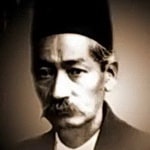Gholāmhossein Darvish Khan
 Gholāmhossein Darvish, known as Darvish Khan, born in 1872 a Tehran is a famous musician and teacher of music traditional Iranian in the last period of the Qajar. Gholāmhossein at the age of ten attended the music branch of the Nezām school dependent on Dar ol-Fonun, where he learned the musical notes and learned to play the small tabl (sort of drum, or timpano).
Gholāmhossein Darvish, known as Darvish Khan, born in 1872 a Tehran is a famous musician and teacher of music traditional Iranian in the last period of the Qajar. Gholāmhossein at the age of ten attended the music branch of the Nezām school dependent on Dar ol-Fonun, where he learned the musical notes and learned to play the small tabl (sort of drum, or timpano).
After years of playing with the tar (long-handled lute) and in particular the setar (three-stringed lute and a beaded lute) his skill was shown and he became the best pupil of his master reaching a high level.
Darvish, with the organization of teaching classes for music lovers and tar and setar, formed an orchestra and directed public concerts, with the aim of making Iran's music more popular and took initiatives to help to assist the needy and the afflicted.
A concert to raise funds for the needy of Russia, one to create the school of culture, one for the citizens of Āmol who had suffered a fire, one to rebuild the ruins as a result of the destruction of the bazaar and also one for the looted of Urumyeh, all these initiatives bear witness to his efforts in this direction.
Darvish was also endowed with a particular talent, and this made him invent some forms of Iranian music among which we can mention the stabilization of the reng (rhythm, the "dance" used above all as the end of the musical performance), the invention of dar āmad (prelude) and the addition of the sixth string to the tar.
He divided the Iranian dastgāh (modal scales identified in various repertoires of melodies) into seven sections and composed numerous songs of which only 22 remained (seven pish dar āmad, ie preludes, six tasnifs, sort of "ballad" in which to the metric structure answers a "rhythmic counterpoint" and 9 reng) that make good the idea of his talent and his potential.
He is among the first in Iran to have organized music teaching classes and some famous Iranian musicians were his students. To the students who had obtained the best results in the various teaching periods, I used to give recognition as a sort of copper and silver halberd or for the students of the highest, golden levels.
Darvish Khān switched off the 22 September 1926 due to an accident (the first victim of car accidents in Iran). On that occasion the newspapers wrote "the tar died". His mausoleum is in Tehrān.

